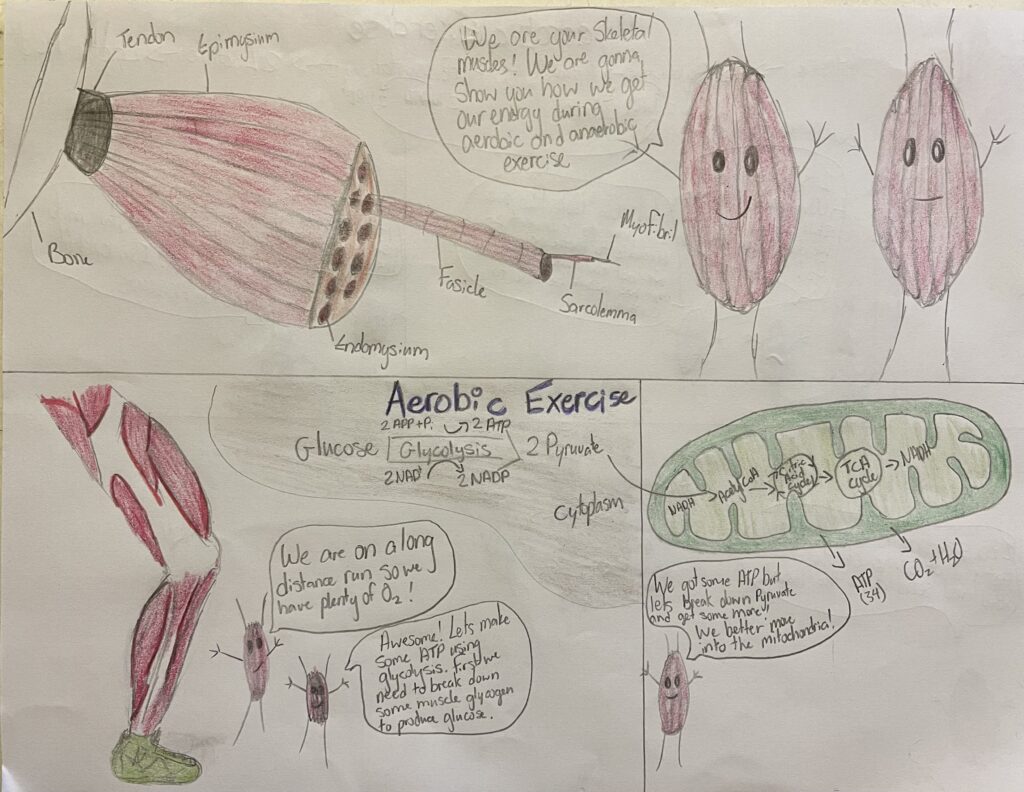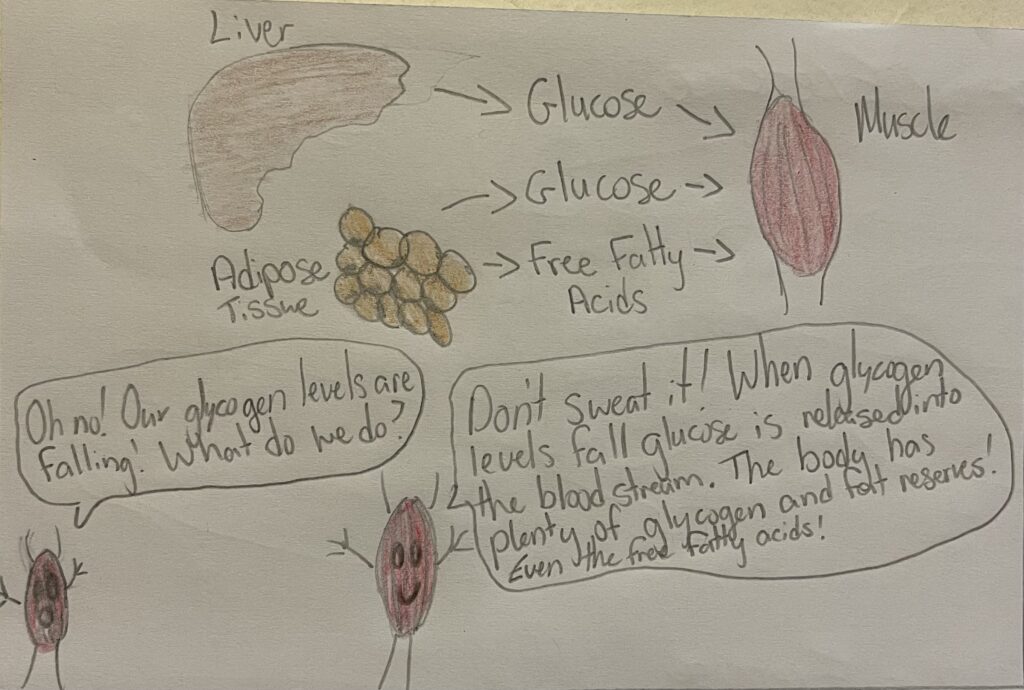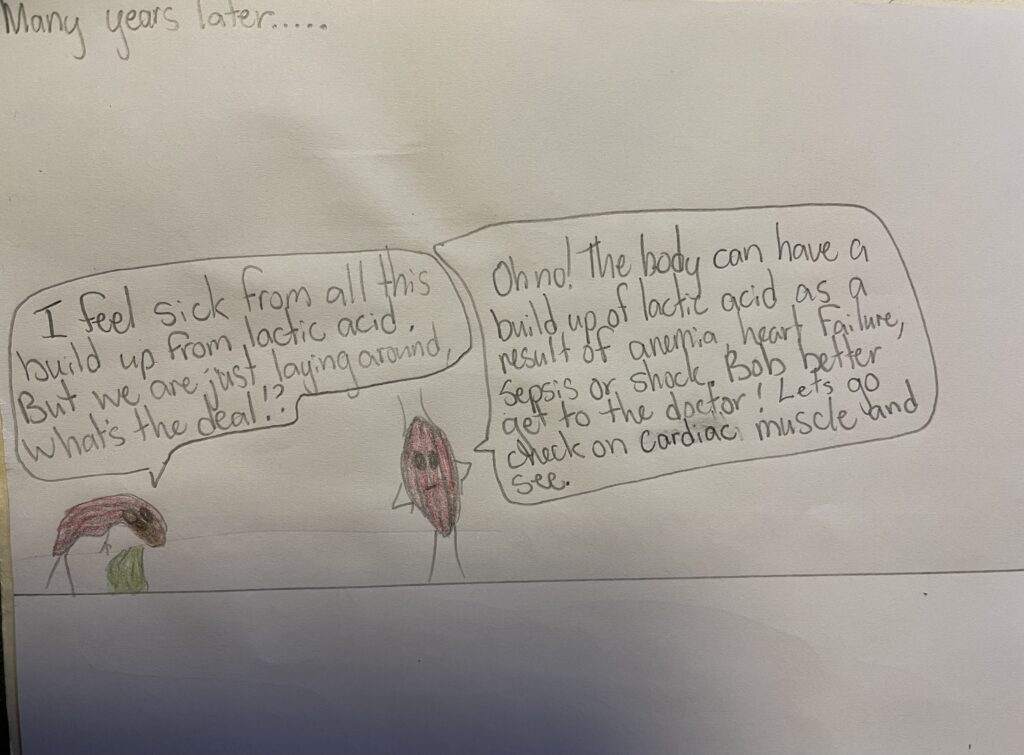



For my STEAM project, I concentrated on the muscles, unit #5. The particular course objective I focused on in my project is “know the different energy molecules in the cell and their use in anaerobic and aerobic exercise”. For my piece, I created a comic that depicts the skeletal muscles in a cartoon form talking amongst themselves about what they will need to do in order to perform while the body is undergoing certain physical activities. When the person starts to do a high-intensity exercise such as a 400 m sprint the muscles will have less oxygen and will need to function anaerobically. In contrast when the person starts to do a low-intensity exercise such as a long-distance run the muscles will have enough oxygen to function aerobically. This change in oxygen availability will create a different environment for the muscles to function and will change the way that the muscles are able to produce energy to maintain the movement of the body.
Skeletal muscle is required for the body to be able to move. In order to contract, muscles require a source of energy which the muscles get through ATP. There are several pathways through which the body produces ATP. Direct phosphorylation of ADP by creatine phosphate is a coupled reaction that uses the Creatine kinase enzyme to transfer the phosphate to create Creatine and ATP. This process is very quick and requires no oxygen consumption(Larson). The process of glycolysis breaks down glucose into two Pyruvate molecules. If oxygen is available the Pyruvate will enter the citric acid cycle within the mitochondrial matrix and go through oxidative phosphorylation. Oxidative phosphorylation requires oxygen so during anaerobic exercise when oxygen levels are too low this process is unable to take place. Without oxygen, the Pyruvate will remain in the cytoplasm of the cell where it gets converted into lactate through a process called anaerobic glycolysis. Anaerobic glycolysis produces two net ATP molecules whereas oxidative phosphorylation produces 32 net ATP molecules(Larson). Although anaerobic glycolysis is less efficient than aerobic glycolysis in producing ATP, anaerobic glycolysis is about 100 times faster than oxidative phosphorylation (Melkonian & Schury, 2019).
Levels of lactic acid buildup in the body also have clinical significance in diagnosing (Melkonian & Schury, 2019). An increase of lactic acid can be observed when oxygen demands exceed the oxygen input/delivery which can be observed in anemia, heart failure, sepsis, and shock. The amount of lactic acid in the body can help to create a management plan for these conditions. The Warburg effect is the observation of a shift from aerobic to anaerobic metabolism that is seen within cancerous tumor cells. The rapidly growing tumor cells expand beyond what the local blood supply is able to adequately oxygenate the cells and so the cells must switch from aerobic to anaerobic glycolysis (Melkonian & Schury, 2019). Some studies have shown that treatments that elevate mitochondrial coupling raise the efficiency in which the muscles can exercise as well as the capacity for sustained exercise in both young and old muscle (Conley et al., 2016).
References
Conley, K. E., Lindstedt, S. L., & Hoppeler, H. H. (2016, January 1). Mitochondria to motion: Optimizing oxidative phosphorylation to improve exercise performance. The Company of Biologists. Retrieved July 18, 2022, from https://journals.biologists.com/jeb/article/219/2/243/33487/Mitochondria-to-motion-optimizing-oxidative
Khan Academy. (n.d.). Oxidative phosphorylation | biology (article). Khan Academy. Retrieved July 20, 2022, from https://www.khanacademy.org/science/ap-biology/cellular-energetics/cellular-respiration-ap/a/oxidative-phosphorylation-etc
Larson, D. Muscles [slides 30-41]. Blackboardonline@UAF. classes.alaska.edu
Melkonian, E. A., & Schury, M. P. (2019, September 20). Biochemistry, Anaerobic Glycolysis. Europe PMC. Retrieved July 19, 2022, from https://europepmc.org/article/NBK/nbk546695

The beginning of the STEAM project explains what the project entails and what to expect through the project. It also explains the objectives of the project and what the art piece of the project covers. This is a great way to help others understand what the STEAM project entails.
The first paragraph explains muscle contraction in a great way that is easy to understand. The explanation of the muscles is a great way to cover what the objective of the project was to complete. The paragraph also introduced a citation which was great and included interesting information with support for what was being explained.
The second paragraph introduced the new material that was being covered. The material focused on the support of lactic acid and the support of oxygen. It also introduced what changes when lactic acid and oxygen are introduced into muscles. The material introduced other sources and citations that were very interesting. The material explained in the written portion did support scientific matters and explained more about muscles.
The overall written piece of the project covered all the materials explained and it included over three new sources which were great sources that introduced great explanations for the new material being introduced. Beginning the written project with the objective and the unit was beneficial and it was very easy to identify later in the written project. The written project included citations for both paragraphs which were covering different material and that was also a great way to distribute sources. The STEAM project was great and interesting.